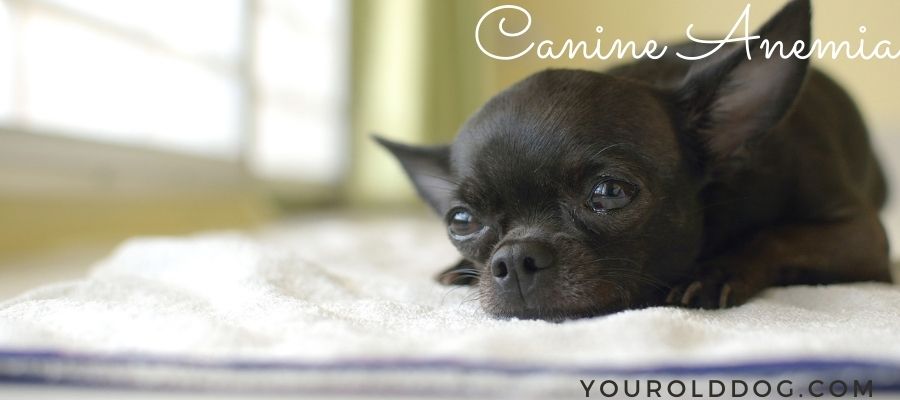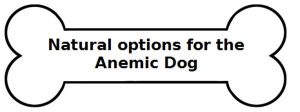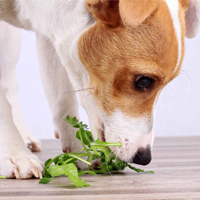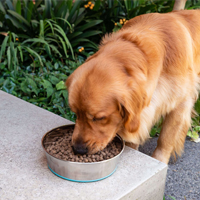
Canine Anemia: Causes, Symptoms and Treatment Options
Plainly put, canine anemia is a deficiency of red blood cells in your dog’s circulatory system.
When the concentration of red cells to whole blood is less than 37 percent by volume in an adult dog, the dog is generally considered anemic. Normal range is said to be between 39 and 60 percent.
Causes of Anemia in Dogs
There are basically three causes of anemia: destruction of red blood cells, insufficient production of red blood cells and blood loss.
There are certain blood disorders that can also result in anemia, of course, and other slower conditions can lead to it as well.
Bleeding in the gastrointestinal tract, from ulcers or cancer, can also lead to anemia in older dogs. Here’s a better break down of the causes of anemia in older dogs:
Anemia caused by blood-loss
- Fleas, ticks and/or worms
- Internal bleeding from trauma to organs or blood vessels
- Tumors
- Diseases that block correct blood clotting in the body
Then, once in awhile anemia is brought on in senior dogs by bigger issues such as:
- Red blood cell destruction
- Autoimmune disease, particularly hemolytic anemia
- Cancer
- Chemical or toxic poisoning
- Parasites in the blood
Insufficient production of red blood cells:
- Chronic diseases such as liver and kidney disease
- Very poor diet and nutritional deficiencies
- Autoimmune diseases such as Hypothyroidism
- Toxic chemicals
- Cancer

Symptoms
Red blood cells carry oxygen, so any symptoms your older dog may experience from anemia come as the result of the blood not having enough oxygen. This means that signs of anemia include lethargy, a loss of appetite and weakness.
Your dog will go through these sorts of symptoms because he is quite literally being starved of oxygen. These can make the heart work harder to get less blood to the organs and muscle tissue, which effectively means that the heart will beat faster. Your dog may also breathe quicker or may have trouble breathing outright.
Another common symptom is paleness of the mucous membranes, which is generally spotted inside the dog’s mouth. The gums and tongue can be anywhere from a pale pink color to white.
Diagnosing Anemia
The good news here is that figuring out if your dog is anemic is a pretty painless process.
The most common diagnostic tool is checking the blood and doing a complete count of blood cells. This blood test is called a “packed cell volume” and involves a drop of blood being examined by spinning in a centrifuge to separate red blood cells from the rest of the liquid matter.
In some cases, a veterinarian may perform a urinalysis to determine if your dog may be losing blood cells through the urine or through any urinary tract infections. A coagulation panel can also be utilized to check your dog’s blood clotting ability. It’s important to note that the diagnosis of anemia will not necessary define the cause of your dog’s anemia. This is something that other tests will help with.

Natural Treatment
If your dog is suffering from IMHA (Immune Medicated Hemolytic Anemia), please Google the term “IMHA dog natural” and you should find a store that carries an entire kit for this condition for dogs and you can have it over-nighted.
Please also take a look at this excellent elixir here for help with stabilizing your dog’s anemia: Blood Support Elixir for Dogs
Because anemia can be a life-threatening condition, you need to get your pet to the vet as soon as possible if you suspect he or she may be suffering from it. Finding the underlying causes is the best course forward when it comes to treating it and you need to get the ball rolling as soon as possible. (https://www.echelon.health/)
Anemia treatment centers around controlling any blood loss and restoring red blood cell volume back to healthy levels. This can entail anything from IV fluid therapy to transfusions that include appropriate blood cells and bone marrow where needed. Vitamin K1 is sometimes prescribed for disorders related to how the blood coagulates, while various herbs (such as alfalfa) and other supplements are also useful.
Other Helpful Food & Supplements
A diet that is very rich in iron, protein and B12 is essential. The following foods are considered to be especially helpful:
- Beef liver which is high in protein, B vitamins and iron
- Nutritional yeast with B12 added
- Leafy green vegetables for iron and minerals
- Kelp powder for its iodine and trace mineral content
- Vitamin C, 500-2,000 mgs a day depending on the dog’s weight. Vitamin C helps to absorb iron from the intestinal tract
References: Dr. Pitcairns Complete Guide To Natural Health & VCA Hospitals










